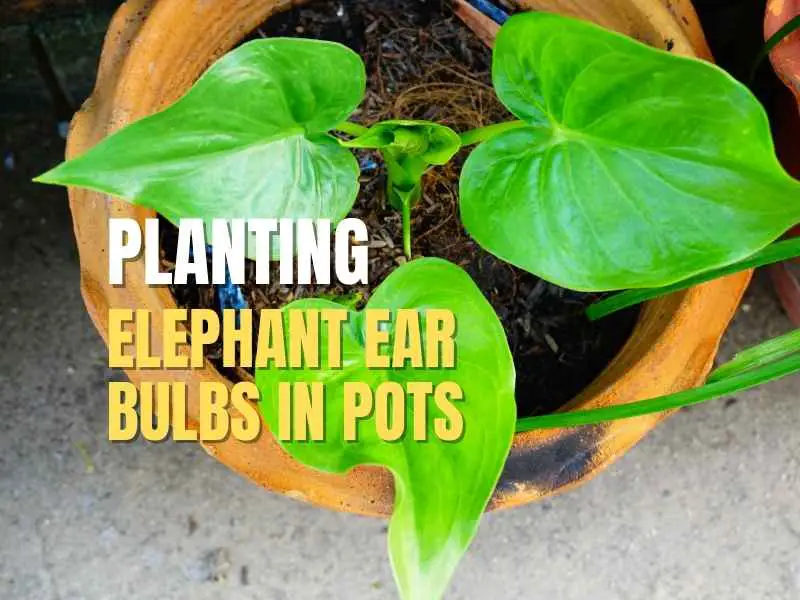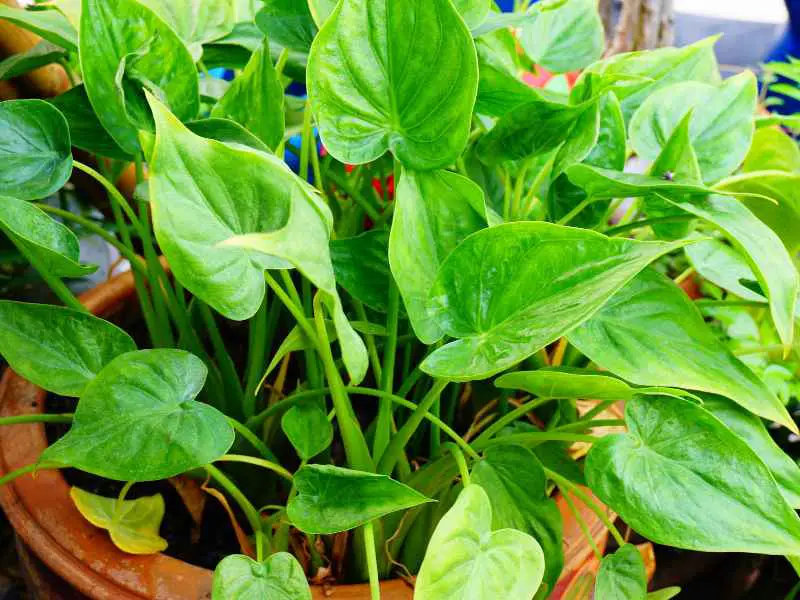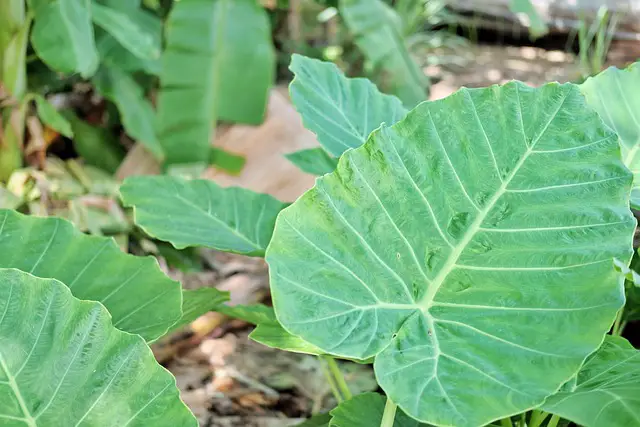Elephant ear plants belong to the Colocasia and Alocasia groups of plants. These are plants with long leaves up to two feet in length. The good news is that both of these plant groups can be grown easily in containers or pots. We will learn about planting elephant ear bulbs in pots.

As this plant produces large leaves, container or pot selection for them is a very crucial step. Because of their large size, these plants need proper care, nutrition, and sunlight. So you need to be careful during the complete process.
Elephant Ear Plant
Elephant ears are grown best in warm weather conditions. These tropical plants produce lime green, blue, black, or purple leaves. They have a bold texture with eye-catching, attractive, and dramatic foliage. Elephant ears also produce flowers but these flowers are not the reason why people grow them. They are grown for their large beautiful leaves.
Two main groups of this plant are mentioned above. Alocasia and Colocasia both of them can easily be grown in pots, indoors or outdoors. The basic difference between both of the plant groups is their leaf orientation. Alocasia leaves are pointed in an upward direction whereas Colocasia leaves have tips pointing downwards.
Keep one thing in mind elephant ears are toxic plants. They contain oxalates which are poisonous so keep your loved ones away from this plant, especially your children and pets.
Planting Elephant Ear Bulbs in Pots
You have to get the bulbs of elephant ear plants, they are also commonly known as corms. But there’s a difference between corm and bulbs. Compressed leaves form bulbs whereas corms are made up of stems. Whichever you choose, they are used to grow elephant ears. Follow the detailed steps given below to grow this plant in pots or containers.
Choosing the Pot for Elephant Ears
These plants have massive sizes, so growing them in containers will require proper care, and pots or containers should also be chosen very carefully.
Pot Size
The size of the container depends on which variety of elephant ears you are growing. If you are growing Colocasia you need a pot 1 and a half feet in depth (18 inches). Whereas for Alocasia the depth of your container should be at 3 feet (36 inches) at least.
Do elephant ears grow well in pots?

It is recommended to start the growing process in large containers. This is very beneficial in the long run because you don’t need to change the pot at later stages. Larger pots also take a longer time to dry out completely which makes it easier to manage the water needs of plants.
Pot Composition
Another important factor while choosing the container for elephant ears is the material by which it is made. Elephant ears love moist soil, so choose a pot that is made up of plastic, fiberglass, or any nonporous material. This keeps the moisture retained in the container. The container should also have plenty of drainage holes, this would eliminate the possibility of water standing in the pot.
Choosing the best location for Elephant Ear
The selection of the right spot depends upon the variety of plants you are growing. Some plants need full sunlight while others prefer partial sunlight. Full sunlight means 6 hours of direct sunlight per day whereas partial means 2 to 3 hours of direct sunlight.
Can elephant ears take full sun?
Choose a spot where your elephant ear can take 4 to 6 hours of sunlight per day. If you notice the leaves of your plant changing color to brown or looking bleached, you need to change the spot as your plant is getting more harsh sunlight. Move it to the place where it gets less sunlight than it was getting before.
Prepare the Soil for the Elephant Ear Plant
It is time to fill your pots with soil that suits best your elephant ears. Avoid using regular garden soil. Your soil should be having good drainage but it also should be able to hold the moisture.
What kind of soil do elephant ears need?
Fill the pot with lightweight potting soil, the mixture of peat moss, vermiculite, and sand would be perfect for your plant. The pH should be between 5.5 to 6.5. You can also use commercial potting soil for growing the plant as this soil contains enough nutrients that are required by elephant ears.
Soil that contains clay or anything that can retain a lot of moisture is dangerous for your elephant ear. This type of soil can become cause your plant to get overwatered.
Adding Compost to the Soil
At the initial growing stage, the elephant ears need nutrients and fertilizers. Adding compost before planting the bulbs in the soil is recommended. Add compost or manure to the soil by adding a 2-inch layer on top of it. You don’t necessarily need store-bought compost. Homemade organic compost would also work better.
Adding slow-release fertilizer is also beneficial as it would provide your plant with much-needed vitamins and nutrients.
Elephant Ear plant can cause Allergies
Safety first fellows, you need to be safe while you are going to plant the elephant ear bulbs. These plants are toxic and they contain oxalates. If you have sensitive skin, these bulbs can cause irritation. So it is recommended to wear some gloves or any kind of protection to remain safe. Don’t touch your face or eyes while working with them.
Burry the Elephant Ear Bulbs
Which side of the elephant ear bulb is up?
Now you need to bury the bulbs in the soil. Dig a hole in the middle of your pot. The hole should be 6 to 8 inches deep. Look for the flat root end of the bulb because you have to keep it pointing down while planting the bulbs.
Place the bulb such that the top of the bulb should be at least 4 inches deep in the soil. As elephant ears are massive plants, they need a lot of space to grow. One elephant ear plant would require about 6 feet of space. Therefore avoid planting more than one bulb in a single pot.
More Care for Elephant Ear Plant

The steps mentioned above deal with the initial stage of planting. Now you need to provide your plant with more care regarding its watering needs, fertilizing, and keeping it safe from harsh weather conditions.
Watering the Elephant Ear Plants
These big plants grow really fast, to develop this much size you can imagine how much water they would require. So water your elephant ear plant on a daily basis. Don’t let the soil run out dry. Keep checking the soil at regular intervals.
Do elephant ears need a lot of water?
Container soil gets dry quickly, so keep an eye on it. This plant needs moist soil all the time. During summers, you may need to provide more water to your plant.
Fertilizing the Elephant Ear Plant
Being a fast grower this plant would also demand regular fertilization from you. You don’t want a stunted growth of your plant. So fertilize it often with nutrient-rich fertilizer.
Using a 10-10-10 or a 20-20-20 fertilizer would provide it with the required nutrients. Feeding the plant once every 3 to 4 weeks is recommended.
Tips for the End of Growing Season
Once the growing season of elephant ears is over, you would notice your plant going dormant. This happens in the fall season when temperatures start to drop in cold areas. During this time you need to stop watering your plant. Once you see the deal foliage, use pruners to cut them off.
Multiply Your Elephant Ear Plant
During the dormant stage, if you notice your plants getting bigger for the container, you can use the division technique to multiply the plant. Dig the soil and divide the bulbs, now you can plant them in a different place or container.
Keep your Elephant Ear Safe From Frost
Once your plant gets dormant and you have pruned the dead foliage, you need to shift the plant to a place where it is safe from frost. Freezing temperatures can kill the elephant ears. Move them to some dry and cool spots.
During this period you don’t need to water or fertilize the plant. Once or twice a month watering would be enough. This period may last up to 8 to 10 weeks. Shift the plant outside in the spring season.
Growing Elephant Ears from Bulbs in Pots Indoors
Elephant ears can also be grown indoors. Follow the same steps mentioned above. While picking the spot for your plant indoors, choose a location that gets direct or indirect sunlight.
You need to focus on two main factors while growing them indoors. One is humidity and the other is temperature.
Humidity
Your elephant ear would require high humidity levels. It is a good practice if you use a humidifier where you have placed the pot.
The other way to keep the humidity high is by keeping a tray filled with water near or beneath your elephant ear pot.
Temperature
How do you winterize elephant ears?
Cold temperatures would surely hinder the plant’s growth. So you need to maintain warm temperatures for your elephant ear. The range of 65 to 75 degrees Fahrenheit is suitable for healthy growth. Don’t let the temperature drop below this level.
The last thing you should be worried about when you grow this plant indoors is its fertilization. During the growing season, fertilize it once every couple of weeks. When winter arrives, stop fertilizing the plant.
YOU MAY ALSO LIKE
How To Grow Yukon Gold Potatoes In Containers
How To Start Cauliflower Seeds Indoors
References
https://www.wikihow.com/Plant-Elephant-Ear-Bulbs-in-a-Pot
https://www.gardeningknowhow.com/ornamental/bulbs/elephant-ear/growing-elephant-ear-plants.htm

